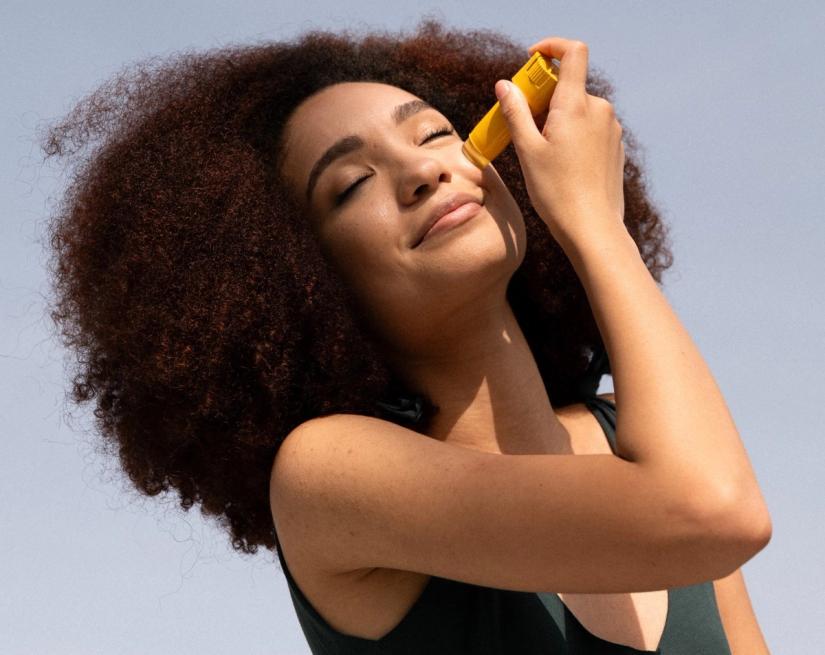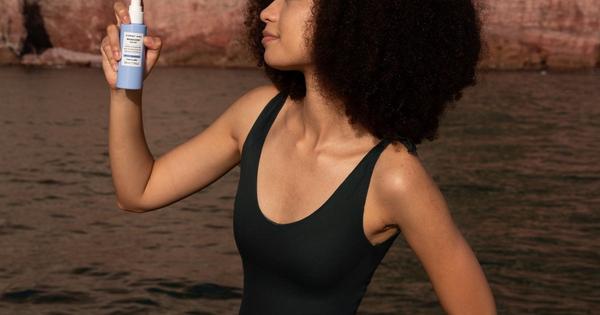Luminant Serum
Dark spot correcting serum
skin care
Eve Mérinville | Corporate RD Excellence & SC RD and Innovation Director
10 min read

Melanin is your skin’s natural defense system—it absorbs and scatters UV rays to reduce the risk of DNA damage, sunburn, and premature aging. This pigment forms a biological “shield,” especially in darker skin tones, offering a form of built-in protection. But melanin can only do so much. Its ability to block UV has limits, which is why daily sunscreen is essential for everyone. Learn how melanin works and why sun protection still matters.
Yes—melanin plays a key role in shielding the skin from harmful ultraviolet (UV) radiation. Acting as the skin’s natural defense system, melanin absorbs and disperses UV rays before they can penetrate deeper layers and damage DNA. This protective pigment helps reduce the risk of sunburn, premature aging, and skin cancer.
However, melanin’s protection isn’t absolute. While those with higher melanin levels do have more built-in defense, no skin type is immune to UV damage. That’s why even with this natural barrier, daily sun protection—like broad-spectrum sunscreen—is still essential for maintaining healthy, resilient skin.
Curious how melanin works on a cellular level and what it really means for your skin health? Keep reading to explore the science behind this powerful pigment.
For many, the memory of waiting to have sunscreen applied before heading outside to play in the summer felt like pure torture. But over time, the importance of protecting skin from UV rays has become clear. What many people don’t realize is that the body already has a natural defense system against the sun: melanin.
Melanin is a natural pigment produced by melanocytes, specialized cells located in the deeper layers of the epidermis. Once produced, melanin is transferred to keratinocytes, the skin’s outermost cells, where it accumulates and serves two key functions:
This complex natural pigment acts as a true physiological shield against UV radiation, helping to reduce the risk of cellular damage. However, melanin alone is not enough to protect against UV, especially during prolonged sun exposure. That’s why using proper sun protection is essential. Combined with melanin’s natural effects, proper sun protection provides broader and more effective coverage to help safeguard our skin.

Understanding that melanin helps shield us from UV rays naturally leads to a deeper question: What’s the mechanism behind this protection? The answer lies in its complex polymeric structure and the presence of two main types of melanin:
Both types absorb harmful UV energy, preventing it from damaging cellular DNA. As confirmed by the renowned study "The Protective Role of Melanin Against UV Damage in Human Skin" by Dr. Michaela Brenner and Dr. Vincent J. Hearing, published in the scientific journal Photochemistry and Photobiology (1), melanin functions as a true natural shield. It absorbs UV energy and either transforms it into harmless heat or dissipates it long before it can harm the DNA of our skin cells.
But melanin’s role doesn’t stop there. According to the same study, our skin cells use melanin to activate a sophisticated defense mechanism that can be summed up in three phases: Reduce, Reuse, Repair.
1-Brenner, M. and Hearing, V.J. (2008), The Protective Role of Melanin Against UV Damage in Human Skin†. Photochemistry and Photobiology, 84: 539-549.
All humans have roughly the same number of melanocytes, regardless of skin color. However, not all of us react to the sun in the same way. The difference in sun sensitivity amongst different skin types isn’t based on the number of melanocytes someone has—it’s in how much pigment they produce. The amount and type of melanin in our skin determine how sensitive we are to UV rays.
Every skin tone results from a unique combination of eumelanin and pheomelanin. Darker skin produces more eumelanin, which offers greater protection against UV rays. Lighter skin, on the other hand, produces more pheomelanin, which provides less UV protection and results in higher sensitivity to sunlight.
Sun exposure can damage the DNA in skin cells and increase the risk of mutations and skin cancers, including melanoma. That’s where melanin steps in. This powerful pigment has unique properties that allow it to protect us in the following ways:
However, while melanin is a powerful natural defense, it’s not enough on its own. You still need a good sunscreen to ensure complete protection, especially during long summer days at the beach, so you can enjoy the sun safely.
The answer to this question is: no, not entirely.
However, we can say that higher levels of melanin in the skin are associated with a reduced risk of UV-induced cellular DNA damage (supported by a well-regarded study from the Department of Dermatology at Nagoya University in Japan [2]). This is a key factor in preventing major forms of melanoma, whose development is often driven by the accumulation of DNA damage. Still, it’s not enough to conclusively state that melanin alone can protect us from developing melanoma.
It’s also important to remember that not all melanin offers the same level of protection against ultraviolet radiation. Pheomelanin has less protective activity than eumelanin and, in some cases, may even be ineffective in reducing oxidative damage, thereby increasing the risk of DNA damage.
2-Kobayashi, N. et al. (1993). Melanin reduces UV-induced DNA damage and cell death in human melanoma cells. J Invest Dermatol, 101(5), 685–689.
Tanning is actually the result of a complex synergy of biological processes involving two main players: the sun and melanin. Sun exposure affects and changes the color of our skin. But what happens beneath the surface of the skin when we tan?
It all starts with melanin, and tanning is essentially a natural defense mechanism. When UV rays from the sun reach the skin, the body responds by increasing melanin production. Melanin acts as an internal sunscreen, absorbing and dispersing excess energy. During this process, melanin darkens, resulting in the golden tone we associate with a tan.
However, not everyone tans—or reacts to the sun—in the same way. People with darker skin naturally produce more eumelanin, which allows them to tan more easily and makes them less prone to sunburning. Those with lighter skin, on the other hand, have a higher concentration of pheomelanin, making them more susceptible to sunburns and UV damage.
High levels of melanin also play a key role in protecting against hyperpigmentation and skin discoloration—those stubborn dark spots that can appear over time as a result of UV-induced damage. Inflammatory processes in the skin, triggered by sun and UV exposure, cause abnormal melanin production. This excess pigment accumulates in the skin, leading to dark spots and hyperpigmentation.
The Luminant line — including the Luminant Cream and Luminant Serum — was created to be a dedicated skincare routine for targeting these pigmentation issues. Luminant products are formulated with specific ingredients designed to:
While melanin provides a first line of defense against damage from ultraviolet rays, protecting our skin externally is just as essential to prevent sunburns, premature aging, and skin cancer. Here are five smart habits to help protect your skin from the harmful effects of the sun and preserve its vitality and health:

Discover the /skin regimen/Lx featuring products formulated with the innovative Longevity Complex™. This powerful blend of antioxidant-rich organic superfood extracts, such as myrtle berry extract, is combined with high-tech ingredients that support the resilience of mature skin cells and protect the longevity of younger ones.
Melanin is a natural pigment that determines our skin’s color and is fundamental in protecting our skin. It absorbs and disperses the energy of ultraviolet rays while helping to reduce DNA damage and prevent sunburn, erythema, or skin irritation. However, melanin is not a sufficient sunshield on its own. Its protective effect depends on three key factors:
For these reasons, even individuals with darker skin or those who tan easily can still experience visible UV-induced damage. Regardless of your skin type, it is still crucial to use comprehensive methods of sun protection and try to reverse sun damage that may have already occurred. Combining the following protective measures can help prolong your skin’s health and vitality:
Sun protection goes beyond just applying SPF—a quality skincare routine can make a significant difference. Strengthening the skin’s natural and intrinsic defenses is important at all times, but it is essential when exposed to ultraviolet rays.
Following this philosophy, Comfort Zone offers treatments not only to prepare the skin for sun exposure but also to target signs of sun damage, such as dark spots and hyperpigmentation. The /skin regimen/Lx line was specifically developed to enhance the skin’s natural defenses and support its vitality over time.
At the heart of the line is the exclusive Longevity Complex™, designed to help protect cellular health and counteract accelerated aging. This unique blend of botanical extracts helps shield the skin from daily external aggressors such as pollution, stress, and free radicals. These two standout products are especially valuable during the warmer months:
When skin is exposed to the sun, it can develop imperfections like dark spots or hyperpigmented areas, often caused by disruptions in melanin production and accumulation in the skin. That’s where the Luminant line comes in.
With its innovative 3-Bright Technology™, it offers a comprehensive and highly effective approach to both preventing and correcting various types of skin discoloration. This technology uses powerful active ingredients to deliver an instant brightening effect, prevent the appearance of new discolorations, and correct existing dark spots. Together, these formulas help restore clarity, balance, and natural radiance to the skin, making them essential allies in any sun-conscious skincare regimen.
Melanin offers powerful, built-in protection—but it’s not a substitute for daily sun care. To keep your skin strong, radiant, and healthy, pair your natural defense with a consistent skincare routine and broad-spectrum SPF. Explore Comfort Zone products to nourish, protect, and support your skin every step of the way.
Dark spot correcting serum
anti-aging sun cream
Anti-spot protection
Brightening serum
Hydra-plumping serum